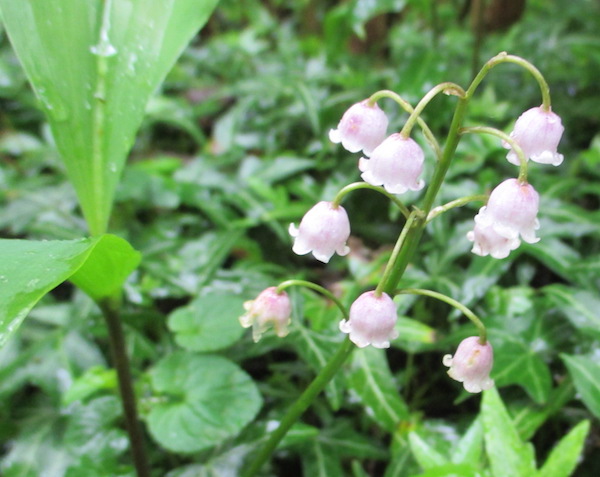| Lily of the Valley is a beloved woodland ground covers whose sweet-scented pure white flowers bloom from April into June. It is also called May Lily, Our Lady's Tears, and Conval Lily. |
| Either there is one species, highly variable, that grows in cool shady deciduous woods in parts of the Northern Hemisphere --or there are three species recognized, albeit similar and doubtless having originated from a common ancestor. Flora North America states: "Convallaria may be viewed as monotypic with three (or more) isolated infraspecific taxa, or else as three morphologically similar but isolated species." |
| In Seattle, Lily of the Valley is cultivated commonly, and reseeds here and there, though most of its increase is due to asexual spreading, to form ever-enlarging patches. It performs best in shade with sufficient moisture. Too much dryness, or too much sun, render it ugly with stress. |
| For many years, I have counseled people that the Old World Lily of the Valley was toxic, while the Seattle native Lily of the Valley (Maianthemum dilatatum) was edible. But then I learned that at least in Japan, some people consumed their native Lily of the Valley as a potherb or in miso soup. |
| Sources I consulted differed in stating how to tell the Japanese from the European species. Some said one was bigger; others said the opposite. One account states that the Japanese has greener rather than blue-green leaves, smaller and thinner leaves, with cuspidate apices, and shorter flower stems with fewer flowers. |
| The European population has been cultivated for hundreds of years, and gardeners have cherished variants such as those plants with pink rather than white flowers; extra-large flowers; double flowers; or foliage variegated or edged with white or yellow stripes. |
| The Japanese species --or rather eastern Asian version of the typical Convallaria majalis, is called in China Ling lan, and in Japan Suzu-ran / Kimigakeso, and in Korea Yeong-nan / Eun-bang-ul-kkot. |
| Medicinal uses exist for Convallaria. But in the West at least, its role as an ornamental garden plant thriving under deciduous trees, is paramount. |
| Since I cannot be certain that a given population of Lily of the Valley found is European or east Asian, and the European has a unmitigated reputation of being poisonous, I have done no ingestion. Tasting a leaf, I found it acrid. It is stated that even water in which cut flowers have been kept, can be deleterious to people. The toxic components are cardiac glycosides such as convallotoxin, convallarin, and convallamarin, and irritant saponins. These substances have been known and named from the 1850s onward. Convallarin possesses purgative properties only, convallamarin is a heart poison allied to digitalin (found in the common foxglove plant) and helleborin. Excess convallamarin can paralyze the heart and so cause death. |
| Even in earlier times, Europeans used the plants medicinally. Below is a quote from Historical Note on Convallaria Majalis by Dr Edward Drummond in British Medical Journal 2(1194) Nov. 17 1883: p. 970: "I have lately met with an account of the use of this drug, in cardiac disease, as far back as the commencement of the seventeenth century, of which I give a translation. It occurs in an old Italian book of Commentaries on the Materia Medica of Dioscorides, by Dr. Pietro Andrea Matthioli (physician to the Emperor and to the Archduke Ferdinand of Austria), and was published in Venice in 1621. He says: The Germans use lily of the valleys to strengthen the heart, the brain, and spiritual parts, and also give it in palpitation, vertigo, epilepsy, and apoplexy; also as a remedy for the bites and stings of poisonous animals; to quicken parturition; and for inflammations of the eyes." |
| According to Gary Lockhart, "the plant was extensively investigated around 1885, and was found to be a useful heart remedy. It about five times stronger than digitalis when injected, but it is poorly absorbed through the stomach walls, so it does not give consistent results orally. The flowers are about twice as strong as the roots and stems." |
| Tanaka's Cyclopedia of Edible Plants of the World (1976) by Tyôzaburô Tanaka and Plants for Human Consumption (1984) by Günther Kunkel, state of Convallaria Keiskei: "Flowers & buds preserved in salt or mixed with leaf tea and drunk; entire plants cooked in miso soups." |
Pulp from the berries may be the plant's least toxic part. Since I cannot tell beyond a reasonable doubt that ingestion of any Convallaria is safe, I deem it off limits, except to gaze at admiringly, and to savor its perfumed scent.
Back |

Convallaria majalis blooming in April; photo by ALJ
|

pink Convallaria majalis blooming in April; photo by ALJ
|

Convallaria majalis berries in September; photo by ALJ
|

